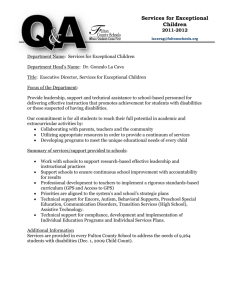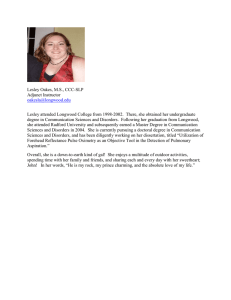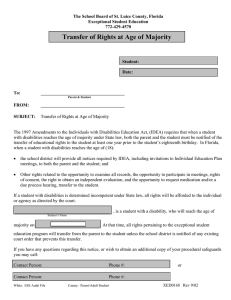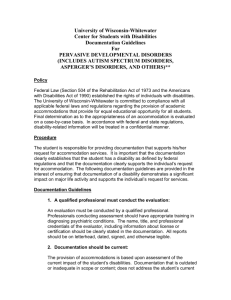SPED 375
advertisement
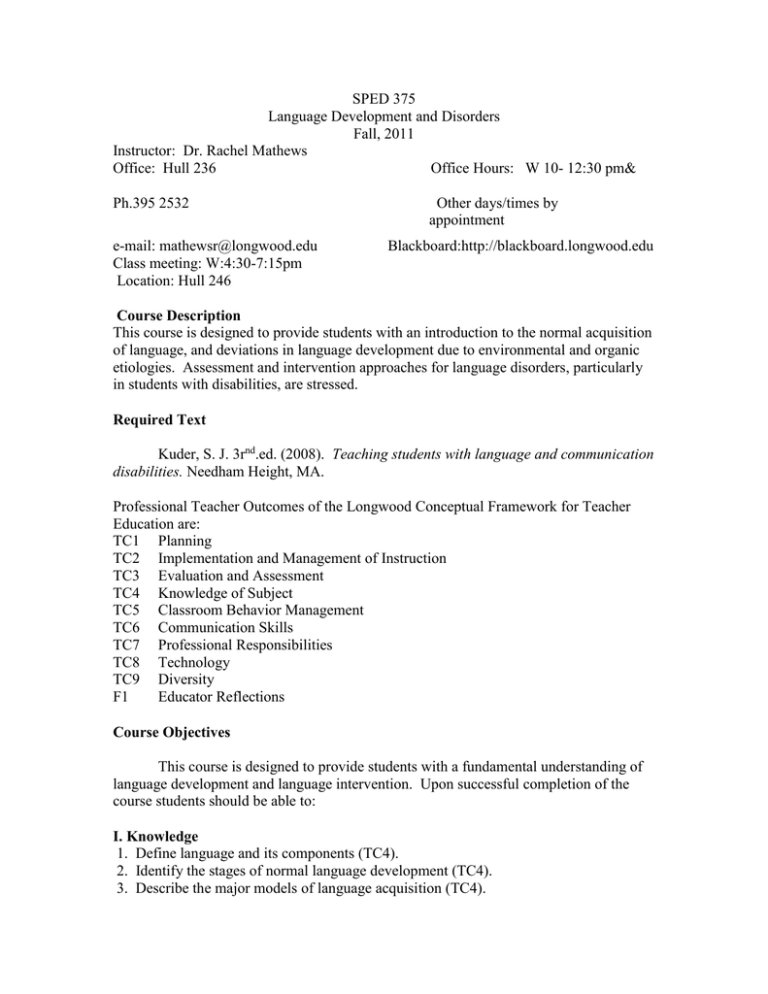
SPED 375 Language Development and Disorders Fall, 2011 Instructor: Dr. Rachel Mathews Office: Hull 236 Office Hours: W 10- 12:30 pm& Ph.395 2532 e-mail: mathewsr@longwood.edu Class meeting: W:4:30-7:15pm Location: Hull 246 Other days/times by appointment Blackboard:http://blackboard.longwood.edu Course Description This course is designed to provide students with an introduction to the normal acquisition of language, and deviations in language development due to environmental and organic etiologies. Assessment and intervention approaches for language disorders, particularly in students with disabilities, are stressed. Required Text Kuder, S. J. 3rnd.ed. (2008). Teaching students with language and communication disabilities. Needham Height, MA. Professional Teacher Outcomes of the Longwood Conceptual Framework for Teacher Education are: TC1 Planning TC2 Implementation and Management of Instruction TC3 Evaluation and Assessment TC4 Knowledge of Subject TC5 Classroom Behavior Management TC6 Communication Skills TC7 Professional Responsibilities TC8 Technology TC9 Diversity F1 Educator Reflections Course Objectives This course is designed to provide students with a fundamental understanding of language development and language intervention. Upon successful completion of the course students should be able to: I. Knowledge 1. Define language and its components (TC4). 2. Identify the stages of normal language development (TC4). 3. Describe the major models of language acquisition (TC4). 2 4. Describe organic and environmental factors that are associated with language delays (TC4). II. Skills 1. Discuss language disorders and their association with various exceptionalities (TC6, F1). 2. Identify, describe, and demonstrate competence in using various tools for assessing language (TC 3). 3. Identify, describe, and demonstrate competence in using methods for enhancing language acquisition in exceptional students (TC2). III. Disposition 1. Demonstrate an understanding of a multicultural perspective on language development and disorders (TC 9). 2. Demonstrate sensitivity to the needs of children and youths with language disorders TC2, TC9). 3. Disseminate information regarding individuals with language disorders (TC 6). 4. Knowledge about the historical development of LD, MR, ED, VI, & HI (TC 1). 5. Membership in a local, state, or national professional organization is required for all students pursuing to be a professional in Special Education (TC 7). Course Requirements Students expecting to earn the highest possible grade in this course must complete the following in a satisfactory and timely manner. Late work will be penalized by one point per day. Furthermore, any work submitted 3 days or more after the Due date will not be accepted. 1. Two tests and a final exam. The tests and final will consist primarily of objective items and short answer questions. 2. Case study Language Sample Case Study Assignment Students will be given two case studies, one from a typical child and another from a child of the same age and gender with atypical language development. Both case studies will present the background of the child as well as a language sample elicited under similar conditions and containing at least 50 utterances ( See more details of this assignment, toward the end of this syllabus). This will be a group project of three students in a group. Your group members are assigned by your instructor (See your group members below). 3. Meeting with the Professor. You (Each group) are required to make an appointment and meet with the professor for consultation three days after getting your graded case study. 4. Oral presentation. Present the above case study to the whole class on the assigned dates. This should be a power point presentation. The length of the presentation is 10 minutes. 3 5. Class Participation The design of this class will require that in each class, the students enrolled participate in activities that will involve small group collaboration, single and /or group presentations. On assigned dates, following a lecture, students will be asked to form small groups and discuss. In these small groups, students will be expected to read or explore the materials or questions provided and present the material briefly to the class (10% of the final grade). Notes on each chapter will be posted on the blackboard. You should read your chapters using the notes before coming to class. Evaluation of Student Performance Grades will be based on the following point values for each course requirements. Quiz 1 Quiz 2 15% 15% Case study analysis and intervention Meeting with the professor for case study consultation Oral Presentation Final Exam Your attitude toward class, and participation 20% 10% 15 % 15% 10% Note: Assignment submitted late will be penalized by 1 point for each day. Excuses or delay will be considered only if supported by a letter from the Dean of this Department and in any case all assignments should be submitted within three days of the due date. Assignments submitted after that three days will not be accepted. Final grading scale: 95-100 A, 89-94 B, 83-88C, 77-82 D, 76 and below F. Note: Students are required to meet all course requirements in order to receive the final course grade. Class Attendance. It is the students’ responsibility to attend class on time for the entire class period. If they miss a class for any reason, they will be held responsible for all material covered and announcements made in their absence. Student should make arrangements with a peer to get any notes/handouts given on the days of their absence. Students are to notify the instructor in advance if they must miss a class for illness or for a recognizable emergency. Their absence from class must be excused if 4 make up privileges are to be granted. Instructor may require documentation for excused absences. Student Health Services can provide documentation only for students hospitalized locally or absent at the direction of Student Health Services personnel.” Faculty Desk Reference, Undergraduate Catalog, Longwood College. Consistent with the Longwood attendance policy, a grade of "F" will be assigned to students missing 25% of scheduled class meetings for excused or unexcused reasons. If you do not complete all of the requirements, you will receive an “F” for the semester. You will have to retake the course in the next semester and complete it in order to meet the requirements of the University. Note: Assignments submitted after the due date will be penalized by 1 point per day. However, assignments submitted after one week of the due date will not be graded. Trivial excuses such as car broke down, printer not working, sick on the previous day etc. will not be excused. Reminders 1. Students are to make note of all test and exam. dates and assignments due dates. No further reminders will be given. 2. It is important to know that grades are not based on the effort made, the total number of classes students enrolled in, or other circumstantial reasons such as the students' job schedule, family situation etc. i.e. grades are based solely on performance. 3. Students should be aware of the duration of each class. The instructor will not dismiss class early to facilitate student work schedules or any other personal problems they may have. Honor Code Students are expected to abide by the Longwood College Honor policy. All tests and assignments are to be pledged. Classroom Manners All Electronic communication modes should be turned off before the beginning of the class. Please do not hold conversations with classmates whenever the instructor or another person is speaking. This includes communication via ‘passing notes or texting. Your undivided attention in class is a must. An atmosphere of mutual respect is in order. Disability Statement: If you are a student with a disability, it is your responsibility to register with the Office of Disability Support Services and to notify your instructor at least two weeks prior to a needed accommodation so reasonable accommodations can be made. Student Classroom Conduct: 5 All students are expected to exercise self-discipline and a respect for the rights of others at all times. Please do not hold conversations with classmates whenever the professor or another person is speaking. This will include passing notes or any other non verbal communication methods. Your undivided attention is a must. An atmosphere of mutual respect is in order. Please be sure that cell phones and beepers are off. Courtesy to others is important. That means respecting the opinions of others, and, in general, doing your part to make this a positive learning environment for all students. Food or beverage, while acceptable, should be as quiet as possible, and you must clean up after yourself. More Important Notes 1. All assignments should be typed, **double spaced**, and submitted on the due dates given. 2. All papers submitted should be **stapled together**. Do not use sleeves. Papers not stapled will not be graded. The instructor will not supply stapler. It is the students' responsibility to read carefully and understand the course syllabus well. If there is anything they do not understand they may seek clarification when they meet with the instructor during their scheduled conference with the professor. Class Schedule Note: This is a tentative schedule and subject to change based on the nature and length of class discussions. Date 8/24 8/31 9/7 9/14 Topic/s Introduction, Syllabus overview Language what is it? Language and language disorders Phonology, morphology, syntax, semantics, & Pragmatics Language acquisition- Bases and models, Social, cognitive bases Rdng. Asmt.(CH/S) 1 1 2 3 6 9/21 9/28 10/5 10/12 10/19 Quiz 1 (Chs. 1-3) Language acquisition -& development - Video Models, expressive language emergence, Language development – preschool years, MLU Language development continued Lang. & Students with Learning Disabilities Language and culture, cultural diversity, dialectal differences, Bilingualism, appropriate assessment and programs 4 5 5 7 16 Submit your Case study Analysis 10/26 11/2 11/9 11/16 11/23 Language & students with Intellectual disabilities Quiz 2 (Chapters 4, 5, 7 , & 16) Language & Students with autism spectrum disorders Case study presentation – 3 groups Augmentative communication - Guest speaker Case study presentation Language and students with emotional/behavioral disorders Method presentation - 3 groups Assessment instruments 8 9 15 13 11/30 Review 7 Dec.7 3-5:50 Final Exam pm All chapters and other material covered Suggested Readings Aldred, C., Green, J., & Adams, C. (2004). A new social communication intervention for children with autism: Pilot randomized controlled treatment study suggesting effectiveness. Journal of Child Psychology and Psychiatry, and Allied Disciplines, 45(8), 1420-1430. Bishop, D. V., & Norbury, C. F. (2002). Exploring the borderlands of autistic disorder and specific language impairment: A study using standardized diagnostic instruments. Journal of Child Psychology and Psychiatry, and Allied Disciplines, 43(7), 917-929. Blamey, P. J. (2001) . Relationship among speech, perception, and production. Journal of Speech, Language, and Hearing Research. 44, 264 – 283. Bedrosian, J.L., Haag, L. A., Johnson, D. & Calculator, S.N. (1998) Communicative competence as perceived by adults with severe speech impairments associated with cerebral palsy. Journal of Speech, Language, and Hearing Research, 41, 667-675. Cascella, P.W., & McNamara, K. (2005). Empowering students with severe disabilities to actualize communication skills. Teaching Exceptional Children, 37(3), 38 – 43. Kircaali-Iftar, G., Birkan, B., & Uysal, A. (1998). Comparing the effects of structural and natural language use during direct instruction with children with mental retardation. Education and Training in Mental Retardation and Developmental Disabilities, 33, 375-385. Koegel, L.K. (2000) Interventions to facilitate communication in autism. 8 Journal of Autism and Developmental Disorders, 30, 393-398. – Lewis, B.A., Freebairn, L.A., & Taylor, H.G. (2000). Follow-up of children with early expressive phonology disorders. Journal of Learning Disabilities, 33, 443 - 444. McLean, J. & Snyder-McLean, L. (1999). How children learn language. San Diego, CA: Singular Publishing Group. Nigam, R (2001). Dynamic assessment of symbol combination by children with autism. Focus on Autism and Other Developmental Disabilities, 16, 190 – 197. Quill, K.A. (2000). Do-Watch-Listen-Say: Social and Communication Intervention for Children with Autism. Baltimore: Paul H. Brookes Publishing Co. Schoenbrodt, L., Kumin, L., & Sloan, J.M. (1997) Learning disabilities existing concomitantly with communication disorder. Journal of Learning Disabilities, 30, 264-281. Shriberg, L.D., Paul, R., McSweeny, J.L., Klin, A., Cohen, D.J., & Volkmar, F.R. (2001) Speech and prosody characteristics of Adolescents and adults with high-functioning autism and asperger syndrome. Journal of Speech,Language, and Hearing Research, 44, 1097-1115. Wetherby, A. M. & Prizant, B. (2000). Autism Spectrum Disorders A Transactional Developmental Perspective. Baltimore: Paul Brookes Publishing Co. Windsor, J. Scott, M.C. Street, C.K. (2000). Verb and noun morphology in the spoken and written language of children with learning disabilities. Journal of Speech, Language, and Hearing Research, 43, 1322 – 1336. Language Sample Case Study Assignment Students will be given two case studies, one from a typical child and another from a child of the same age and gender with atypical language development. Both case studies will present the background of the child as well as a language sample elicited under similar conditions and containing at least 50 utterances. For each child, teacher candidates will: 9 Part I Analysis a. Construct a detailed checklist to include all five language elements b. Use the checklist to analyze both language samples including all specific examples of correct and incorrect usage of each language element c. Compute MLU for each child d. Compute TTR for each child e. Then, in a detailed narrative, compare and contrast the results of the analysis of the language samples across all five elements obtained for the two children. Which child is typical and which child is atypical in his/her language development? How do you know which child is typical and which child is atypical? What theory and what data support your conclusion? Part II Individualized Strategies for the Child with Atypical Language Development a. Describe two individualized strategies you might use to enhance the language development of, and teach communication skills to, the child with atypical language development. Justify each of your suggested strategies using data and theories (This portion will also be presented in class). b. Then, describe specifically how you will provide an effective language model for the child. Be sure to use examples from the language sample. c. Next, specifically describe how you will match your communication strategies to the child’s language proficiency and cultural or linguistic background. Then, assume the child has a primary language other than English. Specifically, what communication strategies and resources could you use to facilitate understanding of subject matter for the child if he or she were an English language learner? d. Now assume that the child with atypical language development is nonspeaking. How might you plan augmentative, alternative, and assistive technologies to support and enhance the communication of the child? Be specific in your answer. Present the information in a typed, double-spaced paper. Be sure to attach and label the two checklists you have constructed as well as your computations for MLU and TTR, each clearly labeled for each child. Divide the written paper into Part I and Part II with appropriate headings and subheadings for each section. Language Sample Case Study Papers will be graded according to the following criteria On time and free from errors (grammar,spelling, etc.) 5 points Two checklists clearly constructed and labeled 5 points Two MLU computations 5 points Two TTR computations 5 points Compare and contrast 5 points Individualized strategies 10 points Effective language model 5 points Strategies match cultural/linguistic background 5 points 10 Augmentative, alternative, and assistive technologies __5 points Total 50 points The Rubric given below will be used for evaluating this project 11 SPED 375 Language Sample Case Study Rubric Category C E C On time and error free Constructs Two Checklists Computes MLU Computes TTR Total Indicator Not Demonstrated Indicator Demonstrated Exemplary Contains frequent errors in spelling or grammar; Handed in after due date Does not construct two checklists; Does not include all five language domains; Does not include all specific examples for appropriate language domains; Misclassifies examples Contains some errors in spelling or grammar or Handed in after due date Constructs two checklists; Includes all five language domains and some specific examples for appropriate language domains; Misclassifies some examples 5 Does not compute MLU or does not compute MLU for one child; Incorrectly computes MLU Does not compute TTR or does not compute TTR for one child; Incorrectly computes TTR Incorrectly determines which child is typical and which is atypical; Does not relate typical and atypical language development to theory or to language sample data; Does not relate typical and atypical language development to child’s exceptional conditions, experience or background Computes MLU for both children; Makes minor computational errors Computes TTR for both children; Makes minor computational errors Correctly determines which child is typical and which is atypical; Relates typical and atypical language development to some theories or to some language sample data; Somewhat relates typical and atypical language development to child’s exceptional conditions, experience or background Contains few errors in spelling or grammar; Handed in by due date Constructs two checklists; Includes all five language domains and all specific examples for appropriate language domains; Correctly classifies all examples Correctly computes MLU for both children Correctly computes TTR for both children 5 Correctly determines which child is typical and which child is atypical; Clearly relates typical and atypical language development to appropriate theories and to appropriate language sample data; Clearly relates typical and atypical language development to child’s exceptional condition, experience, or background Clearly describes two individualized strategies appropriate to enhance language development and teach communication skills to child with exceptional learning needs; Includes strategies that are clearly appropriate and evidence-based 5 Compares and Contrasts Typical and Atypical Language Development 6 Includes Individualize d Language Strategies 6 Describes no or only one individualized strategy to enhance language development and teach communication skills to child with exceptional learning needs; Selected strategy or strategies are not appropriate or evidence-based Describes two individualized strategies to enhance language development and teach communications skills to child with exceptional learning needs, but strategies are not fully explained or strategies are not evidencebased Provides Effective Language Model 6 Does not describe how he/she will provide an effective language model or description is clearly not an effective language model Describes how he/she will provide an effective language model but does not provide specific and appropriate Clearly describes how he/she will provide an effective language model; Presents clear 5 5 10 5 12 examples from the language sample Considers Cultural or Linguistic Background 6 Does not match communication strategies to child’s language proficiency and cultural and linguistic background; Does not include appropriate communication strategies or resources to facilitate understanding of subject matter for child with exceptional learning needs whose primary language is not English Matches some communications strategies to child’s language proficiency or to cultural and linguistic background; Includes some appropriate communication strategies and resources to facilitate understanding of subject matter for child with exceptional learning needs whose primary language is not English Includes augmentativ e, alternative, and assistive technologies 6 Does not demonstrate knowledge of communication and social interaction alternatives for individuals who are nonspeaking; Does not include appropriate augmentative, alternative, and assistive technologies to enhance communication of child Demonstrates some knowledge of communication and social interaction alternatives for individuals who are non-speaking; Includes some appropriate augmentative, alternative, and assistive technologies to enhance communication of child and appropriate examples from the language sample Clearly matches many communication strategies to child’s language proficiency and cultural and linguistic background; Includes appropriate communication strategies and several resources to facilitate understanding of subject matter for child with exceptional learning needs whose primary language is not English Clearly demonstrates knowledge of communication and social interaction alternatives for individuals who are non-speaking; Includes many appropriate and specific augmentative, alternative, and assistive technologies to enhance communication of child. Justification for Variance in Scoring: Strengths: Suggestions: Scale: /50 Grand Total: Grade: Case Study Analysis - Group members 5 5 13 Group Group Group Group Group Group Members Members Members Members Members Members Courtney, Suzanne, Carmen, Monica, Erica, Chelsea, Emily, Missy Hillary Carrie, Hannah, Catie Heather Jennifer M Allison Jennifer A Mandy Samanta Maggie Debbie Tammy Amy
